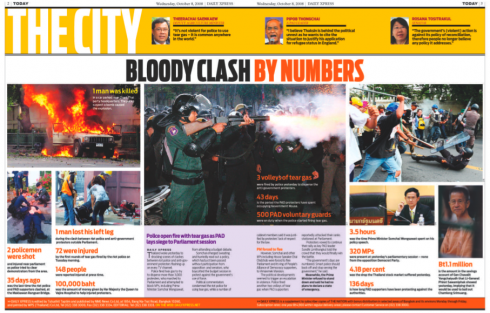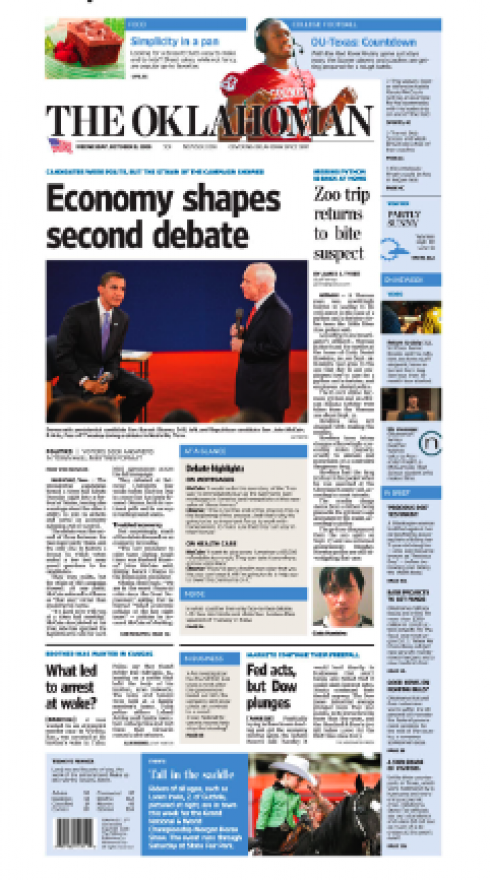

Two items of interest meet at the same intersection of my computer screen:
1. A fabulous piece by Philip Meyer-—whose research of newspapers and insights about the industry have usually been right on target—-peeks into the future, where he sees a more elite newspaper for an audience that will always be hungry for what he calls “evidence-based” journalism.
2. An item in the UK’s Press Gazette reveals that the free newspaper, thelondonpaper, is continuing to grow advertising sales year-on-year – despite the economic slowdown.
Indeed, two very different tidbits of news, both, I believe, pointing to where the future of printed newspapers lie.
We have often mentioned in this blog that we believe the printed newspaper of the future will be published less often than daily, citing as example Germany’s Die Zeit, a highly successful, text driven newspaper—-but one that is visually charged as well, and a constant winner for its elegant design.
We have also heralded the rapid growth of free newspapers worldwide, citing examples of new such newspapers as they appear, as in the case of Bangkok’s Daily Xpress, which we were honored to be a part of.
In his piece, Meyer writes about the need for elite newspapers to satisfy readers who crave them, and who, Meyer believes, always will:
Recently, I took another look at the readership data from the General Social Survey of the National Opinion Research Center at the University of Chicago and tried a different metric. Reasoning that you could still make a pretty good business from an audience reading less than daily, I tracked the percentage of adults who reported reading a newspaper at least once a week. That chart, from 1972 to 2002, shows a much clearer leveling off in the 1980s. Then, at the end of the decade, as though somebody blew a whistle and ordered a column-right march, the line snakes downward again.
Now that information is so plentiful, we don’t need new information so much as help in processing what’s already available. Just as the development of modern agriculture led to a demand for varieties of processed food, the information age has created a demand for processed information. We need someone to put it into context, give it theoretical framing and suggest ways to act on it.
The raw material for this processing is evidence-based journalism, something that bloggers are not good at originating. Not all readers demand such quality, but the educated, opinion-leading, news-junkie core of the audience always will. They will insist on it as a defense against “persuasive communication,” the euphemism for advertising, public relations and spin that exploits the confusion of information overload. Readers need and want to be equipped with truth-based defenses.
Newspapers might have a chance if they can meet that need by holding on to the kind of content that gives them their natural community influence. To keep the resources for doing that, they will have to jettison the frivolous items in the content buffet.
The Economist as a model
If Meyer’s observations are correct, then another wonderful model for the newspaper of the future is The Economist, which, ironically, calls itself a newspaper and not a magazine. The Economist manages to inform, to enhance stories we know about, to place events and people in perspective and never disappoints. Hardly a single story The Economist presents is “news” in the old traditional definition of the term, but the editors manage to engage us as they present what we know in the light of what it means to us. Even the obituaries of The Economist—-often about obscure, but interesting, individuals—-are a treat. One finds himself reading a fascinating tale of a man who spent his life repairing typewriters in New York City as it this was a Harry Potter chapter.
A newspaper that manages to do this well will always have an audience, without a doubt. In addition, information architecture and navigation are impeccable here as well.
Oh, yes, the visuals of The Economist, starting with the cover, are part of what gives it its distinct personality.
Free newspapers in UK growing
For UK free newspapers, apparently the audience is there, as well as the profits.
Two years after News International launched thelondonpaper, the newspaper is continuing to grow advertising sales year-on-year – despite the economic slowdown. Advertising for August was up year-on-year and the title remains on course to break into profit.
Meanwhile, the managing director of free financial paper City AM, Lawson Muncaster, revealed today that his title now plans to extend its distribution to Manchester and Edinburgh next spring.
Thelondonpaper currently has a daily distribution of around 500,000 against rival title Associated Newspapers’ London Lite, which distributes 400,000 and launched at the same time in September 2006.
It is worth noting that the success of free newspapers—-including thelondonpaper—is among younger readers in particular, a case we see as a trend globally.
So, on the one hand we have the core group of elite readers who do not wish a newspaper that is for everybody. Instead, they want a newspaper that deals with analysis and interpretation. On the other, we have the young reader in the big metropolitan areas, who wants a quick read, and free.
I think the future lies somewhere at this intersection, the one where a combination The New York Times/The Economist/Die Zeit meet a colorful free version of USAToday.
Of course, a strong online edition is a vital requirement. The newspaper of the future—-elite or free—-is simply a companion to a robust and newsy online edition.
Just a thought.
![]()
Meyer’s piece in American Journalism Review:
http://www.ajr.org/Article.asp?id=4605
About the free newspapers in the UK:
http://www.pressgazette.co.uk/story.asp?sectioncode=1&storycode=42163&c=1
Covering social disturbance in Thailand
While discussing free newspapers and showing Bangkok’s Daily Xpress, today’s mail brings us pdfs and a note from art director Leroy Sylk, who reports:
Thailand has been hit by major political developments and massive social disturbance. Here’s Xpress cover and The City spread featuring the bloody events. The page 2-3 spread is simple, yet packed with quick information—or fast facts—coupled with powerful images. Wish I could have made them bigger but, well, had to get in the minimum amount of pics that told the story quickly yet effectively. Please take a look.
Here I include today’s front page of Xpress, which deals with the death of an innocent bystander in the midst of the riots:



How are things in Oklahoma?
Several of you have emailed inquiring how The Oklahoman is doing one week after it introduced its new look in the narrower 44” format. Reports from the staff are that all is well, readers adapting. Here is today’s front page:

![]()
Now in Paris, preparing for La Tribune’s launch, scheduled October 20. Fall has arrived here—-visible in the quickly turning leaves, as well as the coolish temperatures.
TheMarioBlog posting #113